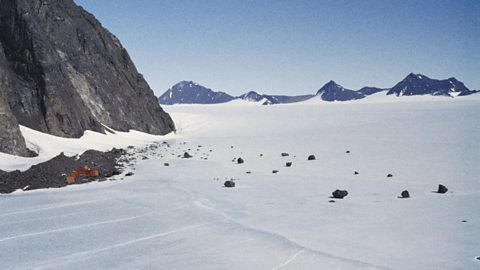Characteristics of cold environments - polar and tundra
Cold environments (both polar and tundra) are found in high latitudeImaginary lines around the Earth running parallel to the equator. These are measured in degrees north or south of the equator. areas and mountainous regions of the world. They have an extreme climate and unique characteristics such as the soil type and the plants and animals found there. The biodiversity in cold environments is relatively low because very few species survive there.
Exploring the characteristics of cold environments and the threats that these areas face
Polar
Characteristics of polar areas include:
- Climate - long cold winters, with annual temperatures mostly below freezing. Polar areas are often windy, with very little precipitationMoisture that falls from the air to the ground. Includes rain, snow, hail, sleet, drizzle, fog and mist. Permanent ice capsA large area of land covered in ice. cover polar landscapes.
- Soil - the soil is covered in ice throughout the year.
- Plants - hundreds of species of mossesSmall plants that grow in damp or shaded places. algae and lichenA type of fungus that grows on rock. survive the harsh conditions of the Polar biome. Few other plants can survive.
- Animals - Polar bears live in the Arctic and penguins live in the Antarctic. Whales, seals and snowy owls are also found in polar regions.

Antarctica is a polar environment
Tundra
Characteristics of the tundra include:
- Climate - cold, windy and little rainfall. Snow covers the ground for much of the year. Average temperature in the Arctic tundra is between -12°C and -6°C. The summer season lasts for 50-60 days each year during which there is permanent daylight.
- permafrostPermanently frozen soil. - this is the layer of frozen soil under the Earth's surface. The frozen ground may extend as deep as 450 m. In the highest latitudes the ground remains frozen all year round. In the most southern parts of the Arctic, the surface layer of the permafrost melts in the summer.
- Soil - this is high in organic material because it is too cold for dead organismLiving entity, eg animals, plants or microorganisms. to decomposeIf a substance decomposes, it breaks down into simpler compounds or elements.
- Plants - trees do not grow in the tundra. When the snow melts, small plants flower. In mountainous areas, cushion plantA compact, low-growing plant which is specially adapted to living in cold environments. grow between the rocks.
- Animals - arctic foxes, polar bears, grey wolves, caribou, snow geese and musk-oxen are found here. In mountainous areas, goats, sheep and marmots can be found. When the surface layer of the permafrost melts in the summer, shallow lakes and bogs appear which attract insects, birds and other wildlife.

A tundra pond in the summer months - surface snows melt, forming a freshwater pond